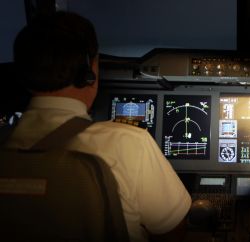Ment al and/or physical fatigue of operators is a significant problem in environments such as the aviation domain due to sometimes unpredictable working hours, long duty periods, circadian (day-night) disruptions and insufficient sleep. All these factors are commonly encountered in modern flight operations, both civil and military. The problem of operator fatigue has been a subject of research at the NLR for many years.
al and/or physical fatigue of operators is a significant problem in environments such as the aviation domain due to sometimes unpredictable working hours, long duty periods, circadian (day-night) disruptions and insufficient sleep. All these factors are commonly encountered in modern flight operations, both civil and military. The problem of operator fatigue has been a subject of research at the NLR for many years.
The level of fatigue is hard to establish unambiguously. The negative effects of fatigue are often underestimated due to the fact that fatigue is difficult to measure, and therefore difficult to quantify. These negative effects may and do lead to aviation errors and accidents. The hazards of fatigue were underscored by the loss of Colgan Air 3407 in 2009.
Flight time limitations (FTLs)
Since the 1930s, flight time limitations (FTLs) have been developed in an attempt to mitigate aircrew fatigue. Over time, FTLs have evolved, driven mainly by industrial pressures or to cope with changing aircraft capabilities. Today, there are major differences among FTL schemes in different parts of the world, which causes differences in crew productivity, crew alertness and airline competitiveness. FTLs tend to be rigid and can limit operational flexibility and efficiency. A troublesome aspect of FTLs is the illusion of safety that may be created: the suggestion that flying within the limits is inherently safe, while flying outside the limits is inherently unsafe.
Fatigue Risk Management System (FRMS) In recent years, new knowledge of fatigue has been combined with safety and risk management processes . This combination created the concept of the Fatigue Risk Management System (FRMS). These systems are based on a scientific approach consisting of a continuous process of registering, predicting and controlling fatigue. A FRMS uses a mathematical fatigue prediction model that needs to be developed to meet the operational needs of an individual operator. A FRMS provides an operator with a safe and efficient tool to manage fatigue. However, as it needs to be developed and validated, it requires more investments than a traditional FTL scheme.
Coach driver The problem of operator fatigue has been a subject of research at the NLR for many years. Obviously, most of this research was focussed on operators in the aviation domain; fixed wing and helicopter cockpit crew, air traffic controllers and UAS (Unmanned Aerial System) operators. Research and consultancy services have been performed on; FTLs, FRMS, fatigue modelling, fatigue awareness training and operator workload, for both civil and military aviation organisations. However, one research project focussed on coach driver fatigue measurement. The project resulted in a low budget solution for measuring real-time coach driver fatigue using head- and eye tracking technology. NLR continues its endeavours to improve modelling, predicting and measuring fatigue to improve aviation safety.

